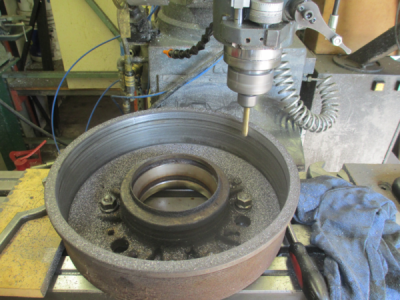Hi all, this is my first question here so if it's in the wrong place I'm sorry.
I'm in the (very slow) process of returning a 1950's Conveyancer forklift to serviceable condition. The first issue I need to address is the complete absence of functional brakes. After no small amount of work I have managed to remove a brake drum (only to have a lining of one of the shoes fall out on the floor - that can't be helping) and found a LOT of wear inside the drum.
From what I can tell the ID of the drum should have been 11", as it measures 11.007 at the opening, however it now measures 11.111 near the face and 11.222 at the worst point just inside the opening, with a rough curve to the wear pattern between those points. OD of the drum is approximately 11.5", so that is why I say a lot of wear.
I have little to no chance of obtaining a replacement brake drum, and due to the method of fitting it is unlikely that I would be able to adapt one from anything else (except maybe another forklift from the same era) so I'm stuck with trying to salvage/repair this one.
I'm not comfortable machining it out to the .222 over, as I feel it would weaken the drum too much. (The machine is 17000 lb fully laden, so I'm not prepared to take any unnecessary risks.) In fact, I'm concerned that even at the .111 over mark that it would be past the manufacturers wear limit.
My question (finally! I know, I write essays - sorry about that) is would it be feasible to reline the drum somehow?
I briefly considered weld and machine, but being cast iron I figured that the resultant nickel build up would be difficult to machine (not to mention the difficulty in actually doing the weld in the first place), so I moved on to the idea of tidying up the existing surface and then machining a sleeve to be shrink fit and then pinned inside the drum.
Does this sound feasible? Safe? Practical?
Cheers,... Jon.
Sent from my Lenovo YT3-X50F using Tapatalk
I'm in the (very slow) process of returning a 1950's Conveyancer forklift to serviceable condition. The first issue I need to address is the complete absence of functional brakes. After no small amount of work I have managed to remove a brake drum (only to have a lining of one of the shoes fall out on the floor - that can't be helping) and found a LOT of wear inside the drum.
From what I can tell the ID of the drum should have been 11", as it measures 11.007 at the opening, however it now measures 11.111 near the face and 11.222 at the worst point just inside the opening, with a rough curve to the wear pattern between those points. OD of the drum is approximately 11.5", so that is why I say a lot of wear.
I have little to no chance of obtaining a replacement brake drum, and due to the method of fitting it is unlikely that I would be able to adapt one from anything else (except maybe another forklift from the same era) so I'm stuck with trying to salvage/repair this one.
I'm not comfortable machining it out to the .222 over, as I feel it would weaken the drum too much. (The machine is 17000 lb fully laden, so I'm not prepared to take any unnecessary risks.) In fact, I'm concerned that even at the .111 over mark that it would be past the manufacturers wear limit.
My question (finally! I know, I write essays - sorry about that) is would it be feasible to reline the drum somehow?
I briefly considered weld and machine, but being cast iron I figured that the resultant nickel build up would be difficult to machine (not to mention the difficulty in actually doing the weld in the first place), so I moved on to the idea of tidying up the existing surface and then machining a sleeve to be shrink fit and then pinned inside the drum.
Does this sound feasible? Safe? Practical?
Cheers,... Jon.
Sent from my Lenovo YT3-X50F using Tapatalk


